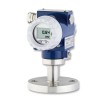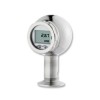HART pressure transmitters utilizing digital communication over standard 4-20mA wiring for advanced diagnostics, remote configuration, and seamless DCS integration.
HART pressure transmitters are intelligent instruments that combine reliable pressure measurement with the advanced capabilities of the Highway Addressable Remote Transducer (HART) communication protocol. These devices superimpose a digital communication signal on the traditional 4-20mA analog output, allowing for remote configuration, comprehensive diagnostics, and access to multiple process variables without the need for additional wiring. This makes them ideal for process engineers and technicians in diverse applications, from chemical processing and power generation to research, who require precise control, enhanced operational insight, and simplified device management through systems like DCS or handheld communicators.
 DPT200 High One Side Overload Differential Pressure Sensor - DP transmitter for measuring pressure difference between two pressure points which can tolerate up a very high overload pressure independently on either the positive or negative side port or both together at the same time.
DPT200 High One Side Overload Differential Pressure Sensor - DP transmitter for measuring pressure difference between two pressure points which can tolerate up a very high overload pressure independently on either the positive or negative side port or both together at the same time. XMPi Process Plant Gauge and Absolute Pressure Transmitter - Process transmitter for measuring vacuum, steam, food, pharmaceutical, oil, gas and other pressure readings necessary for the monitoring and control of bulk production processes.
XMPi Process Plant Gauge and Absolute Pressure Transmitter - Process transmitter for measuring vacuum, steam, food, pharmaceutical, oil, gas and other pressure readings necessary for the monitoring and control of bulk production processes. x|act i Rangeable Flush Pressure Transmitter with LCD Readout - Rangeable Pressure Transmitter with a hygienic all stainless steel construction with LCD digital readout display and optional HART communications.
x|act i Rangeable Flush Pressure Transmitter with LCD Readout - Rangeable Pressure Transmitter with a hygienic all stainless steel construction with LCD digital readout display and optional HART communications.
Find out more about HART® Pressure Transmitters to determine which product options and capabilities will best meet your application requirements.
HART pressure transmitters provide sophisticated measurement capabilities by leveraging the Highway Addressable Remote Transducer (HART) communication protocol, a dominant standard within the process control industry for intelligent field device integration. These transmitters are engineered for seamless configuration using either a plant-wide distributed control system (DCS) or a dedicated handheld HART communicator, offering flexibility in how technicians and engineers interact with the instrumentation. The core advantage of HART technology lies in its ability to superimpose a bi-directional AC digital communication signal onto the standard 4-20mA analog output loop. This digital signal, typically employing Frequency Shift Keying (FSK) based on the Bell 202 standard, uses specific frequencies to represent digital ones and zeros, effectively transmitting additional data without interfering with the primary analog pressure reading.
The ingenious design of HART communication allows for the transfer of a wealth of information beyond just the primary process variable. This includes device status, diagnostic information, calibration parameters, and even secondary or tertiary process variables if the transmitter is multi-functional. This capability transforms the pressure transmitter from a simple sensor into a smart field device, providing deeper insights into both the process and the health of the instrument itself. For instance, an instrument technician can remotely access diagnostic data to identify potential issues before they lead to a failure, or a process engineer can fine-tune device parameters like range or damping from the control room.
One of the most significant practical benefits for design engineers and installation teams is that this enhanced digital communication is achieved without the need for additional wiring or connectors beyond the existing 4-20mA infrastructure. This is particularly advantageous for upgrading legacy systems, as smart HART transmitters can often replace older analog units directly, providing immediate access to advanced diagnostics and remote configuration capabilities with minimal new cabling investment. The “addressable” nature of the HART protocol also means that, in certain configurations, multiple devices can share the same pair of wires, though the point-to-point configuration with digital overlay on the 4-20mA signal is most prevalent for control applications.
Applications for HART pressure transmitters span numerous industrial and research environments. In chemical plants and refineries, they are crucial for monitoring critical pressures in reactors, distillation columns, and pipelines, where the ability to remotely query device status or adjust settings improves safety and operational efficiency. Power generation facilities utilize them for precise measurement of steam pressure, boiler drum levels (via differential pressure), and condenser vacuum. Water and wastewater treatment plants rely on HART transmitters for monitoring line pressures, pump performance, and filter differential pressures, with remote diagnostics aiding in predictive maintenance scheduling. Similarly, in pharmaceutical manufacturing, these transmitters provide accurate pressure data essential for process validation and can be remotely managed to maintain stringent operational standards. Research engineers also benefit from the rich data and configurability when setting up complex experimental apparatus requiring precise pressure control and logging.
Product Help
Device information retrieval
What type of information can you retrieve from a pressure transmitter using HART communications?
All types of HART enabled pressure transmitters are required to include the following device information, which are retrieved using Universal Commands:
- Manufacturer name
- Product type
- Pressure value and units (Primary Variable)
- Output signal and % of scale
- Message (32 characters)
- Pressure range (Lower Range Value – LRV & Upper Range Value – URV)
- Pressure range limits (Lower Sensor Limit LSL & Upper Sensor Limit USL)
- Pressure unit
- Damping time constant
- Final assembly number
In addition to the above Universal Commands a manufacturer may also include further device information such as:
- Date
- Tag number
- Device ID
- Temperature value and units (Secondary variable)
- Software version number
User device configuration
What can you configure on a pressure transmitter using the HART coms protocol?
There are some basic operations that are essential for a user to configure in the field such as the following which are usually available via most HART communication terminals:
- Re-range LRV & URV
- Change the damping time constant value
- Set Tag number
- Change pressure units
Checklist for HART pressure transmitter requirements
Define your HART pressure transmitter requirements using this checklist:
- Pressure range?
- Output signal? 4-20mA with HART coms
- Electrical connection?
- Process connection?
- Process media type?
- Hazardous area?
